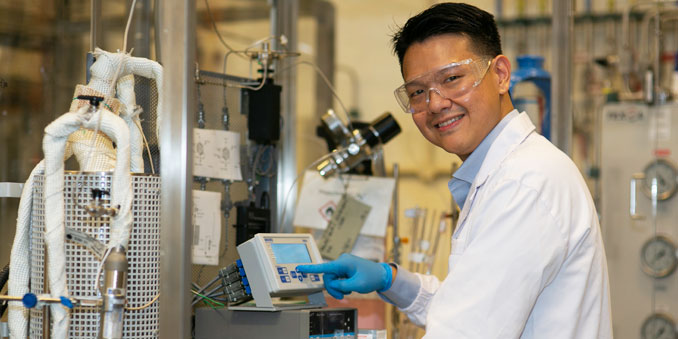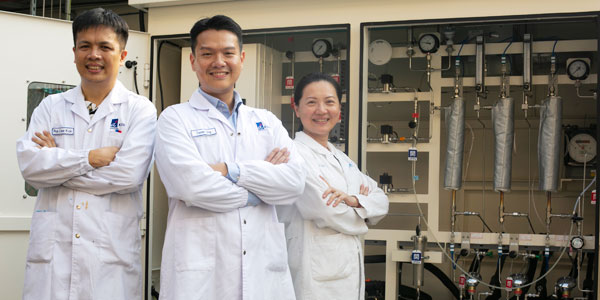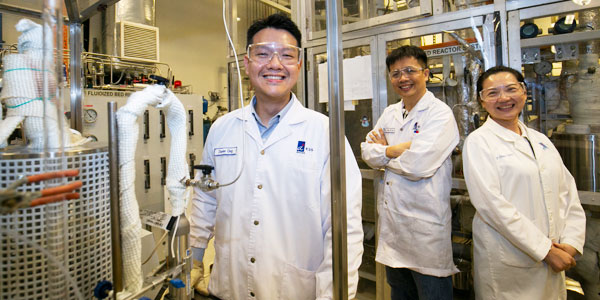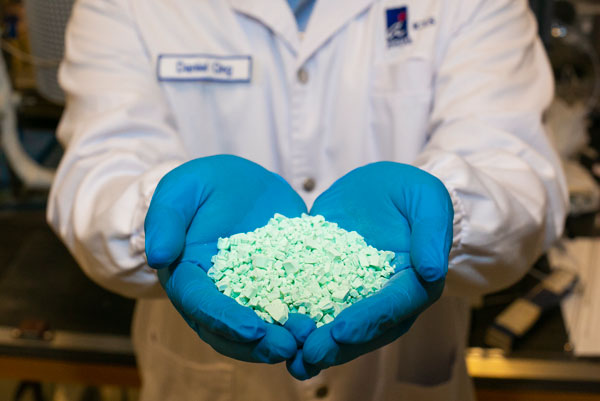FACES OF A*STAR
From carbon dioxide to sustainable fuel energy

Dr Daniel Ong seeks to counter climate change. His latest technology involves converting carbon dioxide, the most significant greenhouse gas affecting global warming, into useful and sustainable fuel energy.
The intensification of carbon dioxide emissions, mainly from the increased consumption of fossil fuels in recent decades, has led to unnatural consequences of adverse climate change.
One man is on a mission to turn carbon dioxide into value-added products – from diesel and lubricants to polymers and even candle wax.
Over the past four years, Dr Daniel Ong, Manager of Strategy and Development from the Agency for Science, Technology and Research (A*STAR)’s Institute of Chemical and Engineering Sciences (ICES), has been doing research on a catalytic system that can efficiently convert carbon dioxide into more useful and environmentally-friendly gases such as methane, which is commonly used in liquefied natural gas for cooking and electricity generation in households.

Left to right: Dr Poh Chee Kok, Dr Daniel Ong and Dr Chen Luwei
A breakthrough was made last year when Dr Ong and his team successfully scaled up the production of the catalyst for the conversion, which increases output from mere grams to several kilogrammes – an important first step toward commercialising and deploying this technology.
Using a culinary analogy, he explained: “You may cook well for a single serving, but when you do so for an entire family, the right proportion, accurate timing and control of many ingredients could be an issue.”
This transformation from greenhouse gas to usable fuel or chemicals is part of a more sustainable circular economy, which could encourage a reduced dependency on fossil fuels.
The aim is to get more companies to use this system, and play a part in combating climate change.
“When we convert something undesirable into useful products, and at the same time reduce our carbon footprint, it gives companies an incentive to adopt this system,” the 39-year-old said.
UNDERSTANDING THE PATTERNS OF THE WORLD THROUGH SCIENCE
Armed with a curious mind, Dr Ong embarked on a journey to learn about the universe through science and mathematics. From a degree in theoretical physics at the National University of Singapore, he went on to pursue his Master in Finance at the Singapore Management University.
When he was awarded an A*STAR Graduate Scholarship in 2006, Dr Ong decided that he needed to dive into engineering to understand science more holistically, and obtained a PhD in chemical engineering at the University of Illinois at Urbana-Champaign.
Studies in the different fields allow me to understand the patterns of the world better.
It was while pursuing his PhD when he realised that he could actually make a difference through his research on photocatalysts – a material that absorbs light energy to accelerate a chemical reaction. Together with his team in ICES, which includes Dr Poh Chee Kok and Dr Chen Luwei, they worked towards abating carbon dioxide emission – a critical problem that is contributing to global warming at an alarming rate.

He has also started teaching his little ones how they can contribute by preventing wastage of water, electricity and food, and recycling materials whenever possible. “It is never too young to start educating the next generation to play their part in sustaining our earth, our home”, said Dr Ong.
SCALING NEW HEIGHTS
Moving forward, Dr Ong and his team are working on the challenge to scale up the catalytic system for mass production stage to enable more companies to join in the fight against excessive emission.

On continuing his fight against global warming, he commented that his team had already embarked on the next milestone – converting carbon dioxide to olefins through a similar process. Olefins as hydrocarbon intermediates can be used to make many useful resins, films and fibres.
This process will convert carbon dioxide into usable fuel and everyday items such as water bottles and candle wax. While the journey is expected to be “complex and complicated”, he is looking forward to the challenge.
“I’ve always felt that science underpins the progress of society. I hope to play a part in it as much as I can”, he said.
Interested in STEM? Learn more about how you can play your part in creating a better world for all with an A*STAR scholarship today!
Was this article helpful?
A*STAR celebrates International Women's Day

From groundbreaking discoveries to cutting-edge research, our researchers are empowering the next generation of female science, technology, engineering and mathematics (STEM) leaders.
Get inspired by our #WomeninSTEM
